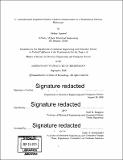A nanofabricated amplitude-division electron interferometer in a transmission electron microscope
Author(s)
Agarwal, Akshay
DownloadFull printable version (6.178Mb)
Other Contributors
Massachusetts Institute of Technology. Department of Electrical Engineering and Computer Science.
Advisor
Karl K. Berggren.
Terms of use
Metadata
Show full item recordAbstract
Wavefront-division electron interferometry with the electron biprism has enabled many applications such as electron holography, exit-wave reconstruction, and demonstration of the Aharonov-Bohm effect. However, wavefront-division interferometry is limited by the requirement of high source coherence. Amplitude-division electron interferometers, first demonstrated by Marton and co-workers in 1954, can overcome this limitation. The implementation of these interferometers is hindered by the precise rotational and translational alignment required. This thesis develops a self-aligned, monolithic electron interferometer consisting of two 45 nm thick silicon layers separated by 20 gm and fabricated from a single crystal silicon cantilever on a transmission electron microscope grid by gallium focused ion-beam milling. Using this interferometer, beam path-separation and interference fringes of lattice periodicity and a maximum contrast of 15% in an unmodified 200 kV transmission electron microscope was demonstrated. This interferometer design can potentially be scaled to millimeter-scale and used in electron holography. It can also be applied to perform fundamental physics experiments such as interaction-free measurement with electrons, with the aim of significantly reducing the damage suffered by biological samples during high-resolution microscopy. Thus, the interferometer can serve as a proof-of-concept of the recently proposed 'Quantum Electron Microscope'.
Description
Thesis: S.M., Massachusetts Institute of Technology, Department of Electrical Engineering and Computer Science, 2016. "September 2016." Cataloged from PDF version of thesis. Includes bibliographical references (pages 56-62).
Date issued
2016Department
Massachusetts Institute of Technology. Department of Electrical Engineering and Computer SciencePublisher
Massachusetts Institute of Technology
Keywords
Electrical Engineering and Computer Science.